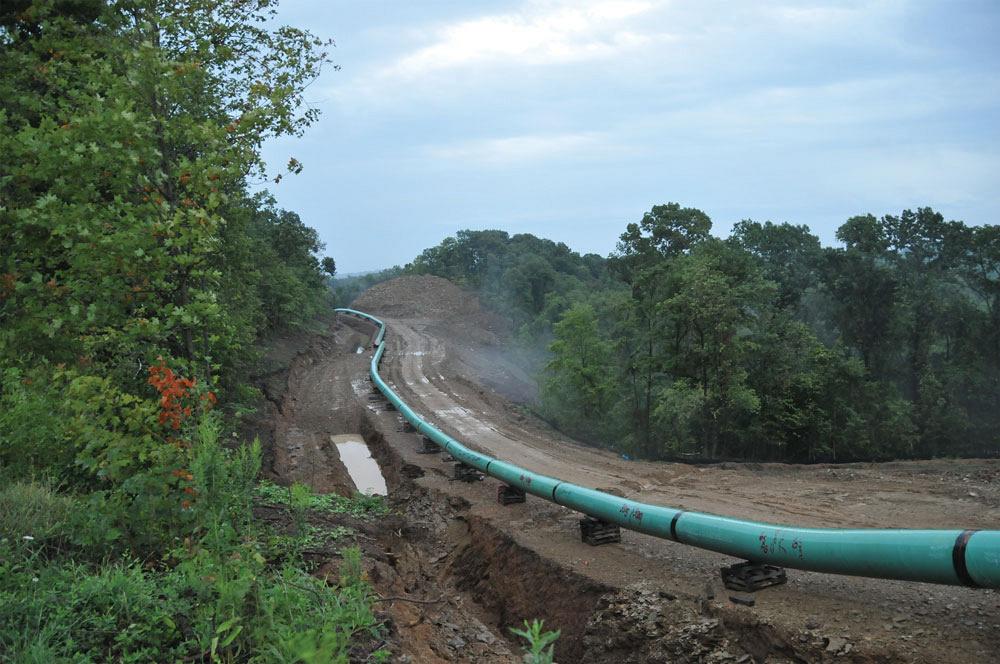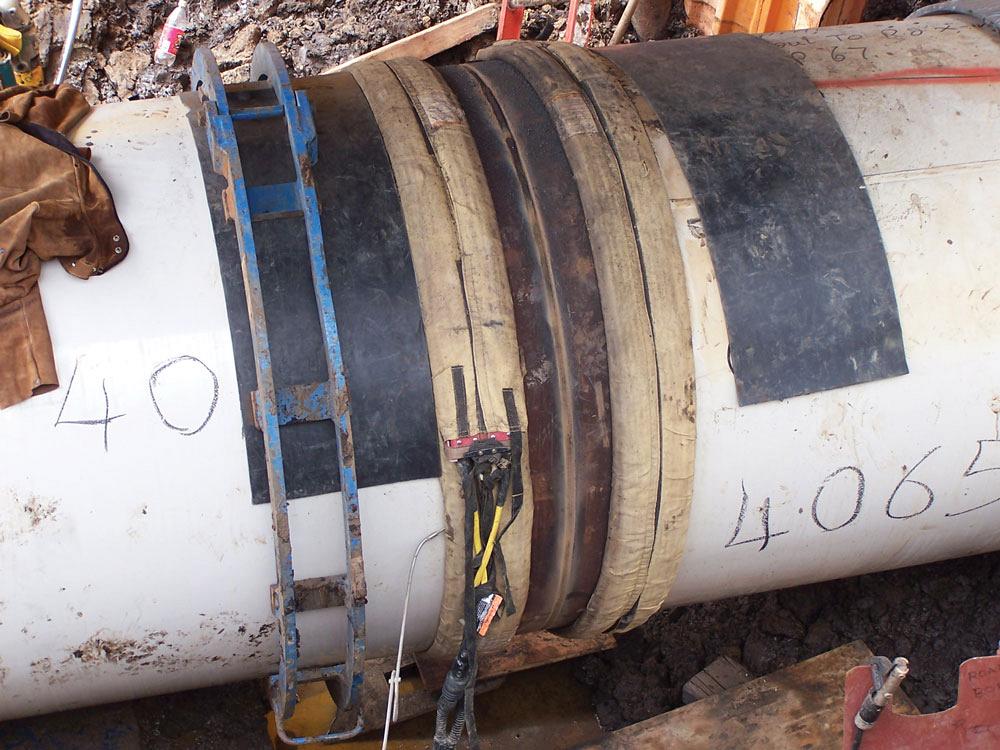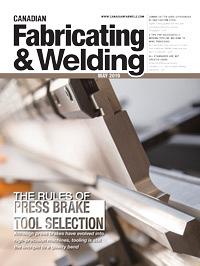Sales and Applications Manager
- FMA
- The Fabricator
- FABTECH
- Canadian Metalworking
How to move pipeline welding to wire processes
As it becomes more common to convert from traditional SMAW, make sure your team is prepared
- By Jim Byrne and Scott MacKay
- Updated May 18, 2023
- May 27, 2019
- Article
- Welding

Contractors are realizing time savings of up to 50 per cent in labour-hours on pipe construction and repair projects with a switch to wire processes such as GMAW or FCAW.
It’s becoming a more common expectation — and even a mandate on some job sites — for contractors to convert from traditional shielded metal arc welding (SMAW) to wire welding processes for pipeline construction and repair.
The move away from cellulosic SMAW in pipeline work is driven by the process’s higher risk of hydrogen cracking, which results in more time and money spent on rework and repair.
A wire-fed welding process decreases the cracking risk and provides additional productivity benefits compared to using SMAW. Contractors are realizing time savings of up to 50 per cent in labour-hours on pipe construction and repair projects with a switch to wire processes such as gas metal arc welding (GMAW) or flux-cored arc welding (FCAW).
Why Change the Pipeline Welding Process?
Traditionally, most pipeline projects in Canada, the U.S., and elsewhere around the world have been completed with the SMAW process, often using a 10 series rod such as 6010 or 7010 for the root pass, followed by an 18 series electrode for the fill and cap passes.
But SMAW uses a cellulosic electrode — a wire coated with cellulose material that acts as a shielding gas to the weld pool as it burns. As the rod burns it can introduce moisture into the weld and result in unacceptable hydrogen levels under pipeline welding procedures. Too much hydrogen in the weld can cause cracking.
The need for a low-hydrogen process that reduces weld failure rates is pushing more contractors to GMAW, FCAW, and metal-cored arc welding (MCAW) processes, coupled with induction heating for weld preheating.
Contractors and pipeline owners are seeing tremendous productivity gains and cost savings with the switch. On one compressor station project, the labour-hours needed to weld a 48-inch-diameter, 3/4-in.-thick pipe joint were reduced from 28 (14 hours per welder for two welders) to 11 (five and a half hours per welder for two welders) — with no defects detected in phased array testing.
So, what are five keys to a successful welding process transition?
No. 1: Plan and train for the pipeline welding process
Planning for a welding process change and considering the ramifications for the operation are crucial to success. A proper plan covers everything from training the welders to understanding the impact on setup and overall productivity.

The need for a low-hydrogen process that reduces weld failure rates is pushing more contractors to GMAW, FCAW, and MCAW processes, coupled with induction heating for weld preheating.
The SMAW process is mechanically very different from wire-fed processes. Welders who have spent their careers using SMAW will need training in a switch to GMAW, FCAW, or MCAW. However, the training for a wire process does not require a significant amount of time; operators often can be up and running in a matter of hours or a few days. Today’s wire-fed machines are designed to make the processes easier to learn, set up, and use for operators of all skill levels, with more forgiving operating windows and technologies that help welders create high-quality welds.
The training should cover not just the welding process and proper technique, such as gun angle, but also the basics of using and adjusting the equipment, including how to choose and install the right consumables.
No. 2: Consider pipeline welding process options
For SMAW welders with little or no experience in wire processes, it can be a big leap to jump right to metal-cored welding, which can offer the biggest benefits for productivity and deposition rates. Contractors may have more success by first converting to something that offers similar performance to SMAW, such as GMAW with a solid wire root pass and flux-cored fill and cap passes.
As welders adjust to a wire process, the operation can continue transitioning its filler metals and processes, gaining more productivity and performance benefits with each step up. An example of this progression is:
- Start with 0.035-in. solid wire for a modified short-circuit GMAW root pass and use flux-cored wire for fill and cap passes (two wires, one gas).
- Use 0.035-in. solid wire for a modified short-circuit GMAW root pass and pulsed GMAW fill and cap passes (one wire, one gas).
- Use metal-cored wire from root to cap (one wire, one gas).
Metal-cored wires are tubular wires filled with alloying powders designed to affect the mechanical properties and chemical composition of the weld. The inclusion of iron powder in these wires helps deliver very high deposition rates — they are like the sports car of welding wires — but they don’t have a flux to hold the bead in place. Metal-cored wires offer substantial benefits for productivity and efficiency but can be a difficult transition for welders with no experience using them.
Flux-cored wires, by comparison, are more forgiving and perform similarly to SMAW electrodes, so welders can more easily make the transition. Keep in mind that flux-cored wires do have a flux that requires post-weld cleaning and grinding, which adds time to the process.
A modified short-circuit GMAW process is a low-hydrogen process that is also more forgiving to variations in fit-up or changes in wire stick-out. In this process, the welding system anticipates and controls the short circuit, then reduces the welding current to create a consistent metal transfer. This precisely controlled metal transfer provides uniform droplet deposition, making it easier for the operator to control the weld puddle. This process can be used for the root pass and is often paired with flux-cored welding for the fill and cap passes.
No. 3: Take advantage of innovative technology
Equipment designed for greater ease of use can make a process change easier.

Induction is a very efficient preheating method for pipeline welding because little heat is lost in the process, and it provides consistent and uniform heating throughout the part. It also eliminates a potential hydrogen source that is a byproduct of open-flame heating.
When completing pipeline welds with SMAW, it’s relatively simple for the welder to tell his helper to increase or decrease by 10 amps. With wire processes, there are two parameters to adjust and balance to make the weld puddle hotter or colder, faster or slower: voltage and wire feed speed.
New welding power sources are designed to simplify parameter adjustments and ensure the correct settings are being used. When the welder’s helper adjusts wire feed speed, for example, these machines automatically set the proper voltage — taking the guesswork out of parameter adjustments.
In addition, modified short-circuit GMAW processes are designed with a more forgiving arc, offering a wider operating window than conventional constant-voltage GMAW. This makes it easier for welders of all skill levels to complete high-quality welds.
No. 4: Make preheating easier with induction
Pipeline welds often require preheating the weld zone to specific temperature ranges. This ensures the joint achieves its required strength and hardness and helps minimize the risk of delayed hydrogen-induced cracking. Several heating methods are available, but induction heating technology delivers benefits for consistency, efficiency, and safety.
Induction is very efficient because little heat is lost in the process, and it provides consistent and uniform heating throughout the part. It’s also easier to hold the temperature at a specific level and constantly monitor heat with induction systems, ensuring the pipe remains within the proper temperature window throughout the weld.
The induction process also eliminates a potential hydrogen source that is a byproduct of the moisture produced by open-flame heating, and the easy setup of the process can provide significant time savings.
In addition, induction offers benefits for safety compared to other heating methods. Because the process induces heat within the part and there is no external heating element, welders can safely work near the induction heating system.
No. 5: Change expectations in the pipeline welding operation
With potential savings of up to 50 per cent in labour-hours on some welding projects, it’s important to think about the effect of these efficiencies on the entire operation when making a switch from SMAW to a wire welding process. Whether it’s the main line, the tie ends, or the substation, there are many different welds in a small area that must be prepped for welding.
If a weld joint used to take eight hours and now takes four, welders can move down the line that much faster. The other parts of the process, such as weld joint fit-up or moving equipment, need to keep up to avoid bottlenecks.
Think about the time needed for all of the non-welding parts of the process, and be sure to build those into the planning. This helps keep the welding on track with less downtime.
More efficient pipeline welding
More pipeline contractors are making the switch from SMAW to a variety of wire processes, including GMAW, FCAW, MCAW, or a modified short-circuit process. Wire processes help control hydrogen in the weld and reduce related rework, while also offering significant productivity and efficiency gains.
Understanding the best options for the application and following key best practices can help contractors maximize success in this transition.
Scott MacKay is district manager and Jim Byrne is sales and applications manager, Miller Electric Mfg. LLC, www.millerwelds.com.
About the Authors
subscribe now


Keep up to date with the latest news, events, and technology for all things metal from our pair of monthly magazines written specifically for Canadian manufacturers!
Start Your Free Subscription- Trending Articles
Aluminum MIG welding wire upgraded with a proprietary and patented surface treatment technology

CWB Group launches full-cycle assessment and training program

Achieving success with mechanized plasma cutting

Hypertherm Associates partners with Rapyuta Robotics

Brushless copper tubing cutter adjusts to ODs up to 2-1/8 in.

- Industry Events
MME Winnipeg
- April 30, 2024
- Winnipeg, ON Canada
CTMA Economic Uncertainty: Helping You Navigate Windsor Seminar
- April 30, 2024
- Windsor, ON Canada
CTMA Economic Uncertainty: Helping You Navigate Kitchener Seminar
- May 2, 2024
- Kitchener, ON Canada
Automate 2024
- May 6 - 9, 2024
- Chicago, IL
ANCA Open House
- May 7 - 8, 2024
- Wixom, MI















